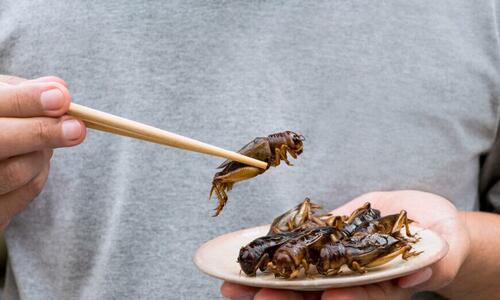from The Epoch Times:
 The edible insect industry is booming. And although the thought of eating bugs may be unappealing, insect protein is already being used for aquaculture, livestock feed, pet foods, and many products intended for human consumption. Insects are also being hailed as a possible solution to world hunger as increasing populations, and limited resources become a growing concern, and food industries are compelled to find viable alternatives.
The edible insect industry is booming. And although the thought of eating bugs may be unappealing, insect protein is already being used for aquaculture, livestock feed, pet foods, and many products intended for human consumption. Insects are also being hailed as a possible solution to world hunger as increasing populations, and limited resources become a growing concern, and food industries are compelled to find viable alternatives.
TRUTH LIVES on at https://sgtreport.tv/

The French biotech firm Ÿnsect has just announced plans to construct a global network of insect farms, significantly ramping up production. Ÿnsect will soon boast the world’s largest vertical insect farm in Amiens, France. The company says the vertical farm model allows the production of more protein using less space and fewer resources. The automated facility is the second in France and claims it will manufacture 20,000 tons of insect-based foods annually.
In December 2022, the company announced it was expanding into the U.S. and Mexico to build insect ingredient production facilities, pushing into two substantial new markets. Ÿnsect also signed a deal with the U.S. flour milling company Ardent Mills to build a factory next to one of its U.S.-Midwest sites, expanding its reach into new territory.
Insects for Human Consumption
For the past decade, Ÿnsect has produced insects used as nutritional additives in pet foods and to feed fish and livestock. That all changed, however, when in early 2021, the European Food Safety Agency declared that mealworms—used whole or as a powder— were deemed safe for human consumption. Ever since, Ÿnsect has been selling powders for baked goods, sports nutrition products, pasta, meat, and meat alternatives—and business is thriving.
Type of Insects
The most popular insects in the edible market intended for humans are black soldier flies, grasshoppers, mealworms, silkworms, and crickets.
Ÿnsect uses two types of mealworms which are the beetle larvae of the Molitor mealworm (also known as Tenebrio molitor) and the Buffalo mealworm (Alphitobius diaperinus).
The FDA
Back in the U.S., we are already eating bugs, mostly unintentionally. According to FDA guidelines, a certain amount of insect parts are, although not desirable, allowed in the foods we eat. The Food and Drug Administration’s Defect Levels Handbook states that certain “natural and unavoidable defects” are allowed in our food and, supposedly, don’t pose threats to humans.
For example, any macaroni and cheese product may contain as many as 225 insect fragments or more per 225 grams of food. Peanut butter allows 30 or more insect fragments up to 100 grams, and wheat flour allows 75 or more insect fragments per 50 grams. Interestingly, the FDA categorizes the presence of insect parts in foods as ‘insect filth,’ and other things it allows in our foods are mold, Drosophila fly eggs, and ‘rodent filth’, which includes hairs and feces. The list is comprehensive and a sobering reminder that we are already consuming insects and many more things we might not have imagined. Simply put, it is all but impossible to keep these contaminants out of our food entirely.
The FDA has long classified insects as ‘filth’, but as we usher in a new era of edible insects, they might want to revise their classification from insects being something it tolerates in the food supply to something people might someday wish to consume.
This disconnect was observed in an article by Marie Boyd, a law professor at the University of South Carolina Law School. In her article entitled “Cricket Soup: A Critical Examination of the Regulation of Insects as Food,” she explains that although the FDA has devoted significant attention to insects as undesirable defects in human food, it has given little attention to insects as human food. She says that, culturally, insects are not commonly considered food in the United States partially because the FDA has categorized insects as ‘filth’ under the Federal Food, Drug, and Cosmetic Act (FDCA). She concludes that by recognizing insects as food, the FDA may help to facilitate greater acceptance of insects as a food source by the general public.



